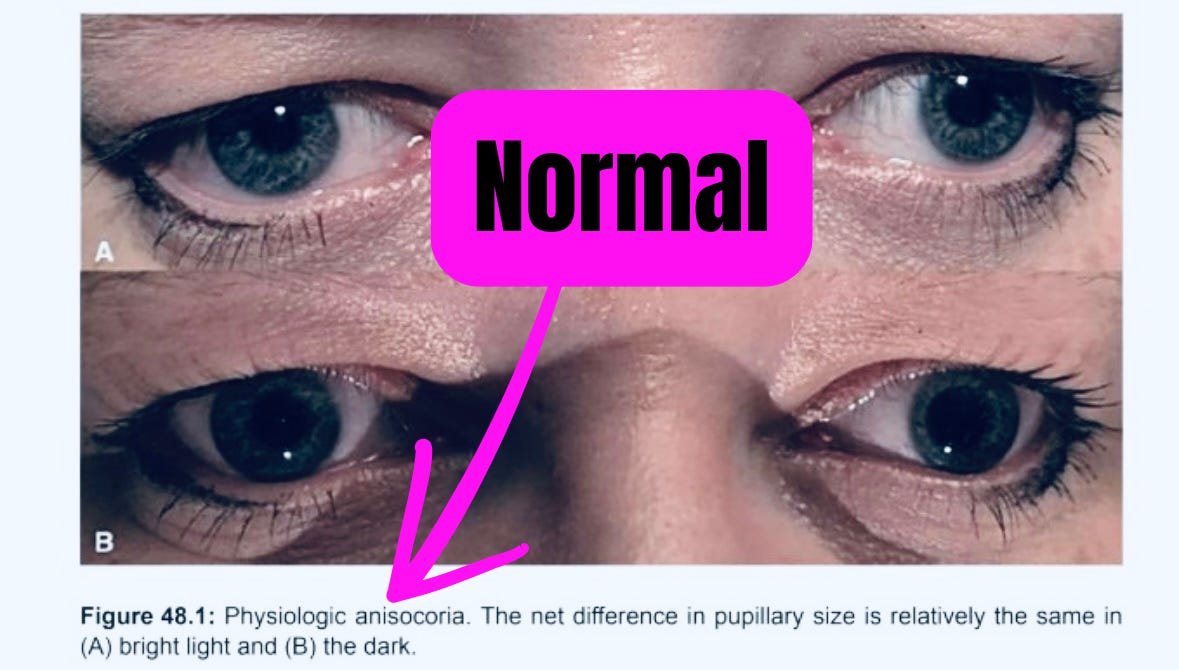One of my pupils is slightly bigger than the other. Totally normal, apparently. The second doctor—who I saw because I didn’t believe the first—took a photo and put it in a textbook as an example of physiologic anisocoria (normal pupil asymmetry). So, I have textbook-normal eyes, which feels like the most aggressively normal thing possible.
And yet… I still wonder if it’s because of that time I accidentally got atropine in one of them. I’ve worn glasses since I was three and I’m basically blind, so how did no one notice I had mismatched pupils for over twenty-five years?
For context, atropine is a compound that occurs naturally in deadly nightshade. It’s also used to dilate eyes. Because nothing screams “put this in your eyeball” quite like a known toxin. I was doing a mouse experiment, and, presumably, adjusted my contact lens with an atropine-soaked glove (don’t tell OSHA).
Now, every time I make eye contact with myself in low light (not recommended), I think of atropine. And because I think of atropine, I think of attempted murder.
Why?
Because that’s how I learned about atropine.
Almost 20 years ago, outside a university in Edinburgh, a professor casually told me that one of his colleagues had tried to murder his wife with atropine in the ’90s, and despite going to prison, he never got fired from his academic post. I haven’t been able to confirm that this last part is true, but the attempted murder part definitely is. And if you like true crime stories, this post is for you.
In August of 1994, on what was probably a typical Scottish summer evening (I’ll let you decide what that means about the weather), Alexandra Agutter asked her husband Paul to make her a gin and tonic. Their marriage was what is now referred to as ethically non-monogamous, which was quite uncommon at the time. Paul had recently introduced Alexandra to his new partner, Carole.
''She seems a perfectly nice person to me,'' added Mrs Agutter. Asked if she had been prepared to accept her husband's relationship, she replied: ''I did not consider it any of my business.'' (The Herald, 1995)
But apparently, that wasn’t enough for Paul. And neither, it seems, was divorce.
The week before, Paul, a toxicology professor, took a vial of atropine from his lab and picked up a case of tonic water from the local Safeway. He injected a little atropine into each bottle, then snuck all but one back onto the shelf at the Safeway. Like a twisted reverse shoplifter. The remaining bottle went into Alexandra’s gin and tonic, along with the rest of the atropine. Fortunately for Alexandra, atropine tastes extremely bitter, and she wasn’t able to finish the drink.
''I thought it tasted incredibly strong. I felt very dry-mouthed, as if I had a terrific amount to drink very quickly.'' She became dizzy, felt heavy and unable to stand up, and began to see everything with a ''gossamer silk'' effect. Then a corner of the room began to bend inwards. ''I just felt pretty weird.'' (The Herald, 1995)
Alexandra had ingested enough atropine to cause serious poisoning. Paul, ever the rational man, did what any guilty husband might do: he left a message with his local doctor’s office, believing it was closed. Unfortunately for him (and very fortunately for Alexandra), the message was received. An ambulance was dispatched immediately. She survived. The drink and tonic bottle were taken for forensic analysis.
At first, Paul wasn’t a suspect.
The laced tonic water he had put back on the shelf poisoned eight people, thankfully not fatally. It wasn’t until CCTV footage surfaced of Paul casually reshelving the doctored bottles that he was arrested. Forensic analysis of the tonic bottles and the remnants of Alexandra’s drink revealed that her gin and tonic contained three times the concentration of atropine found in the bottles he’d returned to the shelf. This, plus traces of atropine found on a cassette tape in Paul’s car, led to his conviction. Alexandra, still believing his innocence, stood by Paul through the trial. But after his conviction and 12-year sentence, she filed for divorce.
The Safeway Poisoner, as news outlets called him, served 7 years of that sentence.
He didn’t return to his old university post (despite the rumors he’d never been fired)… but he did manage to land a part-time position at the University of Manchester.
Doing what, you ask?
Lecturing on medical ethics.
The Herald. (2000, October 10). Woman tells murder-bid trial of relationships during her open marriage to university lecturer wife dismissed the idea of being poisoned. The Herald Scotland. https://www.heraldscotland.com/news/12668559.woman-tells-murder-bid-trial-of-relationships-during-her-open-marriage-to-university-lecturer-wife-dismissed-the-idea-of-being-poisoned/





